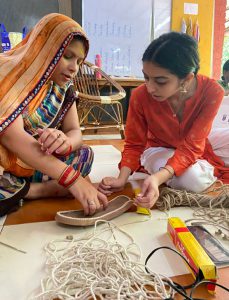Learning outcomes achieved: LO1, LO2, LO3, LO4 and LO7
One of the subjects that I thoroughly enjoy is Design Technology. As a part of one of the activities, I crafted a pair of slippers with a coiled jute base and a macrame design for the top part of it. The entire process of making something hands-on like this, from start to finish, was something very new to me. I was thrilled with my product and happened to wear them during my visit to the Shanti Mandir (ashram) and Shanti Hastakala which is an NGO that aims at helping India’s rural underprivileged. In this NGO, volunteers teach women simple handicraft skills and the profits are used to train more women and to offer them viable and rewarding work opportunities. My aunt, who runs the NGO, noticed my slippers and asked me where I got them from. She was thrilled to find out that I’d made them myself and offered me this amazing opportunity to volunteer and conduct a two-day workshop to teach the design.
LO-1. Identify own strengths and develop areas of growth
Trying to brainstorm and work on crafty ideas has always been fun for me. Hence, thinking of a rough concept and turning that into something tangible seemed fascinating. However, this was easier said than done. The design that I sketched involved a weaving technique called ‘macrame’, which I had never done before and learning this involved a great deal of practice.
Strengths I could associate were commitment and leadership. While conducting the workshop, I felt like I was the person constantly ensuring that the entire group was following through, not facing difficulties and keeping up with me. However, I could have been a better leader had I been well versed in Gujarati. This way I could have reached out to them more effectively.
LO-2. Demonstrate that challenges have been undertaken, developing new skills in the process.
The entire process of learning the technique was super time consuming and challenging. I had to watch so many youtube videos time and again to observe and grasp the techniques. This wasn’t enough, in order to imbibe the skills that I had seen, I had to practice a countless number of times. I would sit for hours, weaving a panel and then opening up every knot, just to start from the very beginning again because it didn’t look perfect. Having practiced so much I finally achieved the outcome I desired and developed an absolutely new skill in the process.
Another challenge was to reach out to people who had a language barrier with me. However, I was lucky to have people who were genuinely excited and interested to learn something new which encouraged me to engage with them even more.
LO-4. Show commitment to and perseverance in CAS experiences
Like I mentioned, I had to watch videos, learn techniques and practise for hours to achieve desired outcomes and all of this required a lot of time, hardwork and most importantly commitment. I would often open up and start afresh. The entire process really tested my patience but it was all worth it in the end.
While conducting the workshop too, I had to be committed. I always tried to explain the knotting styles and techniques, providing alternatives for designs and answering doubts while keeping in mind the time barrier that I had to adhere to.
LO-3. Demonstrate how to initiate and plan a cas experience
Since I was conducting the entire workshop myself, I had to be prepared with all the raw materials beforehand. I had to buy a list of items according to the quantities required which made it essential for me to plan everything in advance. I also had to keep in mind the time duration at hand and divide the entire process so that we could work efficiently. It was crucial for me to divide the entire process into parts and maintain a pace so that every person could keep up. I made it a point to explain and demonstrate each step explicitly.
LO-7. Recognize and consider the ethics of choices and actions
Like I mentioned earlier, this experience included learning a new skill and I watched multiple videos to learn it. So while using the design patterns from a particular video. I was forced to consider the ethical implications and the thin line between ‘being influenced’ and ‘copying’. I ensured that I changed the design a bit after learning the technique so that my piece was not a ‘copy-paste’ from the internet. Moreover, I also gave the original artist credit while presenting the product in front of my class and at Shanti Hastakala.
Finally, I think this particular experience helped me learn a new skill, become more creative and patient in the process. I could see my growth, as a craftsperson and a leader. The learner profile attributes I developed were inquirer, knowledgeable, reflective, communicator and caring. Overall, this experience has helped me acknowledge my privilege to have everything one needs. Witnessing the hard work these people put up every single day, and getting to know more about the kind of simple life they lived made me more humble. I am glad I took up this opportunity.


